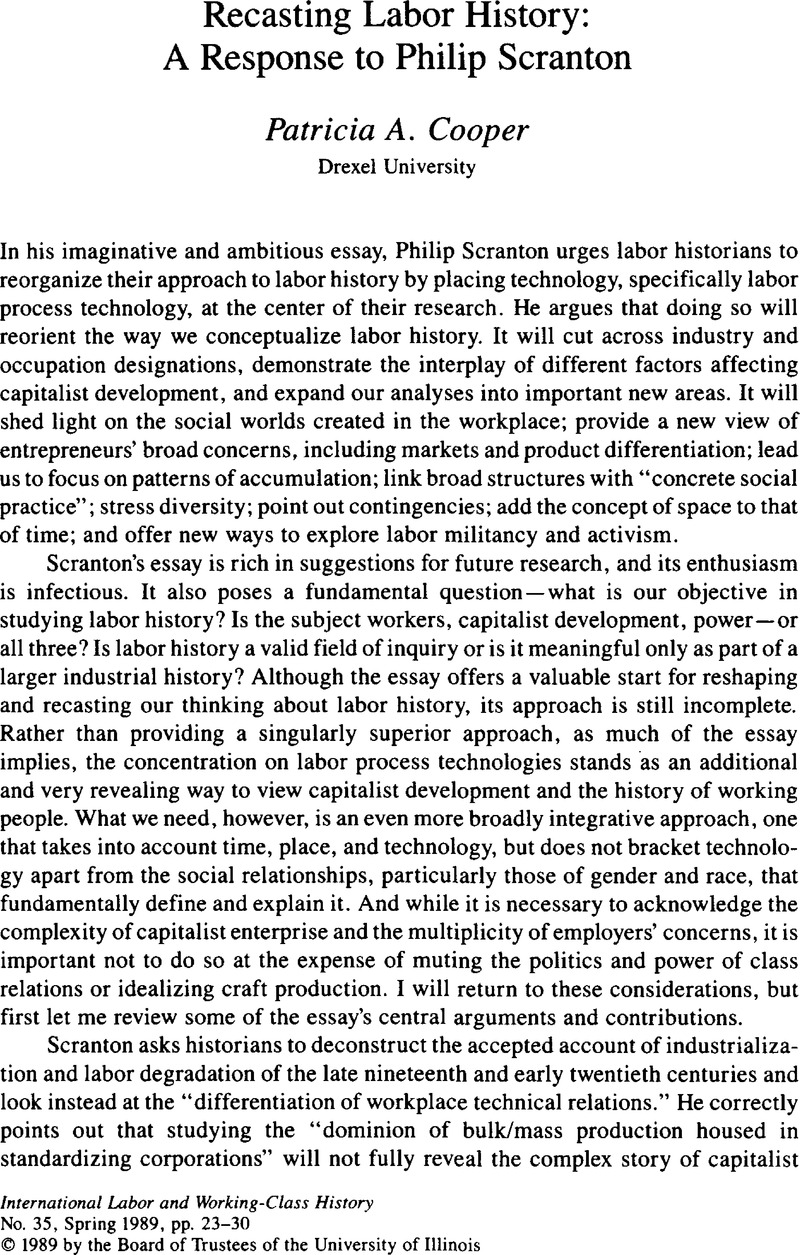Article contents
Recasting Labor History: A Response to Philip Scranton
Published online by Cambridge University Press: 16 December 2008
Abstract

- Type
- Scholarly Controversy
- Information
- Copyright
- Copyright © International Labor and Working-Class History, Inc. 1989
References
NOTES
I would like to thank Ava Baron, Michael Blim, Philip Cannistraro, Carole Turbin, and Gilbert Ware for reading and/or discussing these comments.
1. Scranton's definition of the field of labor history leaves out a considerable amount of research that does not fit his description, especially work that has focused on gender relations and on women. Defining labor history in this way perpetuates the very marginality he wishes to expose. Perhaps we should accord the same level of diversity and differentiation to this group as to any other.
2. Walker, Richard, “Class, Division of Labour and Employment in Space,” in Social Relations and Spatial Structures, ed. Gregory, Derek and Urry, John (New York, 1985), 165, 179–86.Google Scholar
3. Williams, Karel, Cutler, Tony, Williams, John, and Haslam, Colin, “The End of Mass Production,” Economy and Society 16 (08 1987):405–39Google Scholar; Blim, Michael, “A Second Look at Small Is Beautiful: Problems and Prospects for Small-Scale Industrialization in Central Italy and Beyond” (Paper presented at the American Anthropological Association, Philadelphia, Pa., 1986).Google Scholar
4. Piore, Michael J. and Sabel, Charles F., The Second Industrial Divide: Possibilities for Prosperity (New York, 1984)Google Scholar; Williams et al., “End of Mass Production”; Blim, “Second Look.”
5. Patricia Cooper “Working for Philco: The Promise of High-Tech in Philadelphia in the 1930s,” in Towards a History of Urban Political Economy: Explorations in Industrial Philadelphia, ed. Michael Frisch (forthcoming, University of Pennsylvania Press). See also Cooper, , “What This Country Needs Is a Good Five-Cent Cigar,” Technology and Culture (Fall 1988).Google Scholar Storper and Walker argue that unintended effects of employers' policies may work against, rather than for them (“The Spatial Division of Labor: Labor and the Location of Industries,” in Sunbelt/Snowbelt, ed. Sawers, Larry and Tabb, William [New York, 1984], 19–46).Google Scholar Conveyors at Philco, for example, made it easier for workers to shut down production entirely.
6. See also Turbin, Carole, “Piecing Together the Past: A Retrospective Look at Studies of Nineteenth-Century Working-Class Communities” (Paper presented at the American Studies Association, Chicago, Ill., November 1988).Google Scholar
7. Callinicos, Alex, “Anthony Giddens: A Contemporary Critique,” Theory and Society 14 (1985): 133–66CrossRefGoogle Scholar; Porpora, Douglas, “Four Concepts of Social Structure” (Unpublished paper, Drexel University, 1988)Google Scholar; Porpora, , “The Role of Agency in History: The Althusser-Thompson-Anderson Debate,” Current Perspectives in Social Theory 6 (1985):219–41.Google Scholar
8. Baron, Ava, “Deconstructing Capitalist-Patriarchy: A Case for Studying the Gendering of Work” (Paper presented at the Social Science History Association, New Orleans, 1987).Google Scholar See also Sargent, Lydia, Women and Revolution: A Discussion of the Unhappy Marriage of Marxism and Feminism (Boston, 1981).Google Scholar
9. Baron, Ava, “Contested Terrain Revisited: Technology and Gender Definitions of Work in the Printing Industry, 1850–1920,” in Women, Work and Technology: Transformations, ed. Wright, Barbara (Ann Arbor, 1987), 58–83.Google Scholar
10. Turbin, Carole, “Beyond Conventional Wisdom: Women's Wage Work, Household Economic Contribution, and Labor Activism in a Mid-Nineteenth-Century Working-Class Community,” in “To Toil the Livelong Day”: America's Women at Work, 1780–1980, ed. Groneman, Carol and Norton, Mary Beth (Ithaca, 1987), 47–67.Google Scholar
11. Mary Blewett, “The Sexual Division of Labor in the Artisan Tradition in Early Industrial Capitalism of New England Shoemaking, 1780–1860,” in ibid., 35–46.
12. Scott, Joan, “The Mechanization of Women's Work,” Scientific American (1982):166–87.CrossRefGoogle Scholar
13. Elizabeth Clark-Lewis, “‘This Work Had a End’: African-American Domestic Workers in Washington, D.C., 1910–1940,” in Groneman and Norton, eds., “To Toil the Livelong Day”; Janet Golden, “Trouble in the Nursery: Physicians, Families, and Wet Nurses at the End of the Nineteenth Century,” ibid., 125–37; Frank, Dana, “‘The Labor Woman Fights at the Point of Consumption’: Gender, Consumer Organizing, and the Seattle Labor Movement, 1919–1928” (Paper presented at the Berkshire Conference on Women's History, Wellesley, Mass., 1987)Google Scholar; Benson, Susan Porter, “The 1920s Through the Looking Glass of Gender: A Response to David Montgomery,” International Labor and Working-Class History 32 (Fall 1987):36CrossRefGoogle Scholar; Kessler-Harris, Alice, Out to Work: A History of Wage Earning Women in the United States (New York, 1982).Google Scholar
14. Baron, “Contested Terrain Revisited,” 62–75; Milkman, Ruth, Gender at Work: The Dynamics of Job Segregation by Sex during World War II (Urbana, 1987).Google Scholar
15. Baron, “Contested Terrain Revisited,” 61; Phillips, Anne and Taylor, Barbara, “Sex and Skill: Notes Towards a Feminist Economics,” Feminist Review 3 (10 1980):79–88.CrossRefGoogle Scholar
16. Baron, “Contested Terrain Revisited,” 60–61.
- 1
- Cited by




